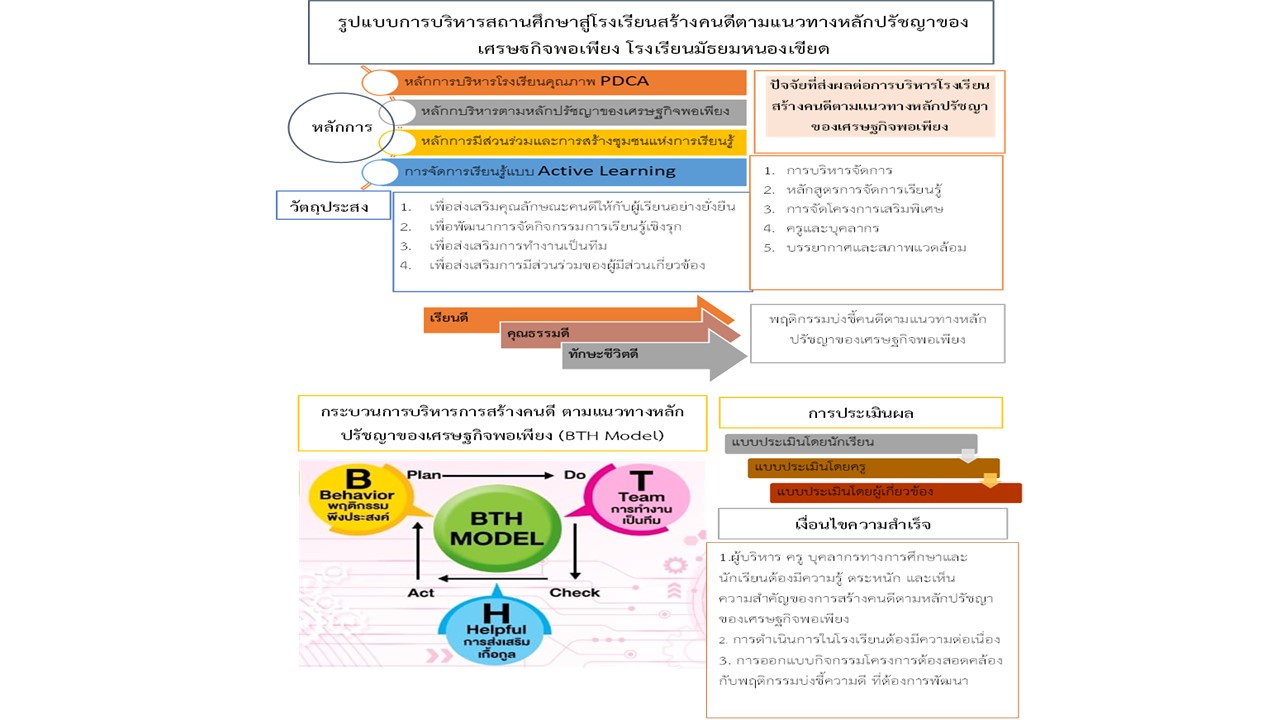การพัฒนารูปแบบการบริหารสถานศึกษาสู่โรงเรียนสร้างคนดีตามแนวทาง หลักปรัชญาของเศรษฐกิจพอเพียง โรงเรียนมัธยมหนองเขียด
Main Article Content
บทคัดย่อ
การวิจัยครั้งนี้มีวัตถุประสงค์เพื่อ 1) ศึกษาปัญหาและแนวทางการบริหารสถานศึกษาสู่โรงเรียนสร้างคนดี 2) สร้างรูปแบบการบริหารสถานศึกษาสู่โรงเรียนสร้างคนดี 3) ศึกษาผลการใช้รูปแบบการบริหารสถานศึกษาสู่โรงเรียนสร้างคนดี และ4) ประเมินและปรับปรุงรูปแบบการบริหารสถานศึกษาสู่โรงเรียนสร้างคนดี ตามแนวทางหลักปรัชญาของเศรษฐกิจพอเพียง การวิจัยและพัฒนาแบ่งออกเป็น 4 ขั้นตอน ประกอบด้วย ขั้นตอนที่ 1 การศึกษาปัญหาและแนวทางการบริหารสถานศึกษาสู่โรงเรียนสร้างคนดี ตามแนวทางหลักปรัชญาของเศรษฐกิจพอเพียง ขั้นตอนที่ 2 พัฒนารูปแบบการบริหารสถานศึกษาสู่โรงเรียนสร้างคนดีตามแนวทางหลักปรัชญาของเศรษฐกิจพอเพียง ขั้นตอนที่ 3 การใช้รูปแบบการบริหารสถานศึกษาสู่โรงเรียนสร้างคนดีตาม แนวทางหลักปรัชญาของเศรษฐกิจพอเพียง ขั้นตอนที่ 4 ประเมินการใช้รูปแบบการบริหารสถานศึกษาสู่โรงเรียนสร้างคนดี ตามแนวทางหลักปรัชญาของเศรษฐกิจพอเพียง ผลการวิจัยพบว่า 1) ปัญหาและแนวทางการบริหารสถานศึกษาสู่โรงเรียนสร้างคนดี ตามแนวทางหลักปรัชญาของเศรษฐกิจพอเพียง แบ่งออกเป็น 5 ด้าน ได้แก่ (1) ด้านการบริหารจัดการศึกษา (2) ด้านหลักสูตรสถานศึกษา (3) ด้านการจัดกิจกรรมการเรียนรู้ (4) ด้านการมีส่วนร่วมของผู้ปกครอง ชุมชนและหน่วยงานที่เกี่ยวข้อง (5) ด้านการพัฒนาครูและบุคลากรทางการศึกษา 2) รูปแบบการบริหารสถานศึกษาสู่โรงเรียนสร้างคนดี ตามแนวทางหลักปรัชญาของเศรษฐกิจพอเพียง BTH Model มีความเหมาะสมและเป็นประโยชน์ในระดับมากที่สุด 3) ผลการประเมินพฤติกรรมคนดี 3 ประการของผู้เรียนหลังใช้รูปแบบมีผลการประเมินในระดับดีสูงกว่าผลการประเมินก่อนใช้รูปแบบ และผลการประเมินความคิดเห็นของนักเรียน ผู้ปกครองนักเรียน ผู้บริหารสถานศึกษา ครูและบุคลากรทางการศึกษาในโรงเรียนที่เข้าร่วมโครงการ โดยรวมอยู่ในระดับมากที่สุด และ4) นักเรียน ผู้ปกครองนักเรียน ผู้บริหารสถานศึกษา ครูและบุคลากรทางการศึกษามีความพึงพอใจอยู่ในระดับมากที่สุด
Article Details
เอกสารอ้างอิง
คณะอนุกรรมการขับเคลื่อนเศรษฐกิจพอเพียง. (2559). การปรับกลไกการขับเคลื่อนเศรษฐกิจพอเพียง. http://www,sufficiencyeconomy.org/network_show.php?ld=153&sid=43&ntuype=14
ธงชัย ดีมูลพันธ์. (2565). การบริหารสถานศึกษาตามหลักปรัชญาของเศรษฐกิจพอเพียงของสถานศึกษา ในสหวิทยศึกษาวังสีทา สังกัดสำนักงานเขตพื้นที่การศึกษาประถมศึกษาสระบุรีเขต 2. การค้นคว้าอิสระ สาขาวิชาการบริหารการศึกษา มหาวิทยาลัยศิลปากร.
นภาพร มูลเมือง. (2564). รูปแบบการบริหารสถานศึกษาตามหลักปรัชญาของเศรษฐกิจพอเพียง ของโรงเรียนพานทองสภาชนูปถัมภ์ สังกัดสำนักงานเขตพื้นที่การศึกษามัธยมศึกษาเขต 18. มหาวิทยาลัยราชภัฏกำแพงเพชร.
ภูดิศ พัดพิน. (2557). การพัฒนารูปแบบการบริหารจัดการสถานศึกษาตามหลักปรัชญาของเศรษฐกิจพอเพียงของโรงเรียนสังกัดสำนักงานคณะกรรมการการศึกษาขั้นพื้นฐาน. วิทยานิพนธ์ปริญญาดุษฎีบัณฑิต มหาวิทยาลัยราชภัฏวไลยอลงกรณ์.
เยาวลักษณ์ เกสรเกศรา. (2562). การพัฒนารูปแบบการบริหารจัดการงานระบบดูแลช่วยเหลือนักเรียนด้านการพัฒนาและส่งเสริมนักเรียนโรงเรียนบ้านหมากหัววัง จังหวัดลำปาง. https://www.kruchiangrai.net/question/
ศรินทิพย์ ทะสะระ. (2564). การพัฒนารูปแบบการบริหารสถานศึกษาตามหลักปรัชญาของเศรษฐกิจพอเพียงของโรงเรียนบ้านวังใหญ่ สำนักงานเขตพื้นที่การศึกษาประถมศึกษาสงขลา เขต 3. https://anyflip.com/usnhj/ajok/basic
สมพร เทพสิทธา. (2558). การเดินตามรอยพระยุคลบาทเศรษฐกิจพอเพียง ช่วยแก้ปัญหาความยากจนและการทุจริตฉบับสมบูรณ์. กรุงเทพฯ: ธรรมสาร.
สำนักงานคณะกรรมการการศึกษาขั้นพื้นฐาน. (2560). การขับเคลื่อนนโยบาย สพฐ. ปี 2560-2561. กรุงเทพฯ: โรงพิมพ์ชุมนุมสหกรณ์การเกษตรแห่งประเทศไทย.
องค์การบริหารส่วนจังหวัดขอนแก่น. (2564). แผนการดำเนินงานประจำปีงบประมาณ 2564. https://kkpao.go.th/kkpao/uploads/journal/636e132b96bd4.pdf
อภิชัย พันธเสน และคณะ. (2559). สังเคราะห์องค์ความรู้เกี่ยวกับเศรษฐกิจพอเพียง. กรุงเทพฯ :
สำนักงานกองทุนสนับสนุนการวิจัย (สกว.).


